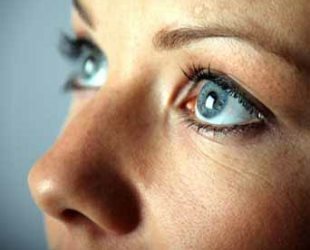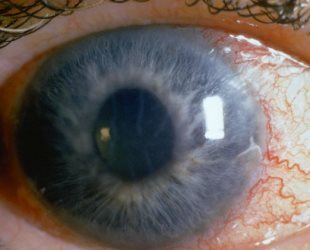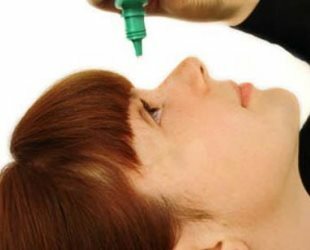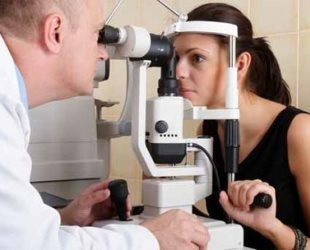
Among all eye diseases, a group of diseases with rather dangerous consequences, called glaucoma, is distinguished.
All types of glaucoma are characterized by increased intraocular pressure( IOP), visual field defects and decreased visual function up to complete loss of vision.
Incredibly, the concept of "glaucoma" unites about 60 eye diseases.
In acute course of the disease the pupil acquires a bluish-greenish murky color, from which the name of the disease( from the Greek "the color of the sea wave", or "azure") occurred. In this article, we will analyze the disease in more detail, because among the causes of blindness, glaucoma is in the first positions.
- 1. Causes of
- 2. Types of
- 3. Mechanism of development of
- problem 4. Symptoms of
- 5. Diagnosis of
- disease 6. Treatment of
- 7. Prevention of
- 8. Useful video of
Causes of
Since there areThe complexity of the definition of the concept of "glaucoma" in specialists disagree on the causes of its occurrence. It is believed that this is the so-called multifactorial disease, which is caused by a combination of various causes:
- heredity,
- abnormalities or individual features in the structure of the eye,
- trauma,
- cardiovascular disease,
- endocrine disorders,
- of the nervous system.
Also the cause of glaucoma is the violation of the withdrawal of intraocular fluid, which leads to an increase in IOP.In this case, defects of the retina, optic nerve, up to its complete atrophy may occur, resulting in blindness.
It should be noted that the increase in IOP occurs not only with glaucoma. This increase in pressure inside the eye is called hypertension. The difference between these two diseases is that when the hypertension is not damaged the optic nerve, and only benign changes occur.
Glaucoma can appear at any age, even in newborns, but is most common among the elderly.
Types of

Read on - what is amblyopia, what are the symptoms of the disease, proper treatment and prevention.
In the article( here) about the complex treatment of dry eye syndrome. Learn all the subtleties of this disease.
The following types of glaucoma are considered depending on the occurrence and course of the disease:
- Congenital glaucoma is most often either genetically predetermined or occurs after intrauterine infections( rubella, syphilis, mumps).The child is born with an enlarged cornea and a high IOP.In people, the disease is called a "bullish eye" or "droopy eye."
- Juvenile( or juvenile) glaucoma occurs between the ages of 3 and 35 years.
- Primary adult glaucoma is the most common form of glaucoma. Occurs with age-related changes in the eyes. It has several forms of percolation.
- Adult secondary glaucoma occurs as a consequence of other eye diseases: cataracts, keratitis, scleritis, atrophy of the iris, eye burns and injuries, etc.
Primary glaucoma can be:
- open-ended: is characterized by a gradual increase in IOP, so it is not immediately noticed by patients. Its name is explained by the fact that with this form of disease the iris-corneal angle is open.
- closed-end: , short-term and then long-lasting moments of pressure increase inside the eye occur, which leads to an acute attack of glaucoma, when the eye becomes hard as a stone.
- mixed: combines features open-angle and angle-closure glaucoma.
- with normal IOP: occurs due to impaired blood circulation within the optic nerve itself.
Mechanism for the development of the
problem The main processes that arise in the eye analyzer for glaucoma are:
- Due to a number of reasons, there is a violation of the outflow of intraocular fluid.
- Because of the large amount of fluid in the eyeball, IOP increases.
- In all tissues of the eye, blood flow is disturbed.
- There is a lack of oxygen in the tissues of the eye, in particular, at the point of exit of the optic nerve.
- Nerve fibers are compressed in the area of their exit from the eyeball, which subsequently leads to their death.
- There is a glaucomatic optic neuropathy( all fibers from the retina to the brain suffer) and the optic nerve is atrophied.
Symptoms of

The main symptoms of glaucoma in its various manifestations are:
- increased intraocular pressure,
- decrease in visual field,
- of the optic nerve.
Although an increase in IOP is difficult to notice, especially when the most common open-angle glaucoma occurs, with the slightest discomfort or visual impairment, you should consult your doctor to avoid menacing consequences.
Increased pressure inside the eye can be suspected at the following signs:
- discomfort in the eyes, heaviness and eye strain,
- fog in the eyes, the presence of a "mesh" in front of the eyes,
- in the eyes,
- appearance of "rainbow circles" when looking at the light,for example, a light bulb,
- eye moisturizing,
- pain around the eyes,
- impaired ability to see at dusk.
Acute attack of glaucoma
An acute attack of glaucoma is usually called a condition in which intraocular pressure suddenly rises above the mark of fifty millimeters of mercury. The causes of an acute attack of glaucoma are:
- physical labor with a prolonged inclination of the head;
- nervous shock and emotional overexertion;
- supercooling;
- excessive fluid intake;
- taking certain medications;
Sometimes an acute attack of glaucoma can occur without obvious reasons, which often happens in elderly patients suffering from a glaucoma of the closed type.
Symptoms of acute attack of glaucoma:
- intense headache and eye pain;
- vomiting and nausea;
- fever and chills;
- heart rate irregularities;
- reddening of the eyes and dilating the pupil, changing its color;
- increased lachrymation and swelling;
- photophobia;
- increased density of the eyeball;
- general weakness.
If the above signs of occur, the following should be done:
- should be dripped into the glaucoma-affected eye of Pilocarpine or Timolol. These medications should be administered every fifteen minutes within an hour of the onset of the attack;
- take inwards 0.5 grams of Diacarb, Fonurita or Diamox;
- put a mustard compress on the calves of the feet;
- go to the department of ophthalmology to measure intraocular pressure and receive medical care.
Diagnosis of the disease
Timely diagnosis of glaucoma is very important to prevent the consequences and the threat of complete blindness of the patient.
The following methods are used to determine IOP and other signs of glaucoma:
- Tonometry is considered the main method of measuring IOP.The measurements are made by a 10-g gauged Maklakov tonometer, while the person is lying. Normally, the pressure should not be more than 26 mm Hg. It is common to measure the diurnal fluctuations of the tonometric pressure when observing the pressure dynamics: for example, the first measurement is carried out in the morning, without getting up from the bed, and the second - after 12 hours. The difference in these measurements should not exceed 5 mm Hg.
- Elastotonometry is also performed using Maklakov tonometers of different weight: 5 g, 7.5 g, 10 g and 15 g. In this case, a graph of the IOP dependence on the mass of the tonometer is obtained. The graph should normally be almost straight. Significant deviations indicate a violation of IOP.
- Tonography is carried out using an electronic tonograph. In this method, not the tonometric but the real pressure inside the eye is determined. Then, according to special tables, the parameters of the hydrodynamics of the eye are calculated: the ease of outflow of moisture, the minute volume of moisture, etc.
- Perimetry is a method of investigation by which the field of view is identified. There are many methods of perimetry, but in diagnosing glaucoma, isoptopyperimetry is more often used( determine the boundaries of the field of vision with the help of objects of different areas) and campimetry( determine the defects of the central field of view).When clinicization is quite common is the method of computer perimetry, which must be done every three months or more often.
Treatment of

The main methods of treatment of glaucoma are drug treatment, laser and surgical operations.
Medication( or conservative) treatment of
The aim of this type of treatment is:
- Decrease of IOP.
- Improvement of blood flow in the visual analyzer.
- Normalization of metabolism in the tissues of the eye.
Most often, anti-glaucoma drops are prescribed for all these tasks, and their effect on the body may be different:
- some drops may not reduce pressure, but on the contrary, increase it;
- to other droplets may develop stability, so they will not have any effect;
- other drugs may not initially cause positive changes, but with regular use of drops IOP gradually begins to decline;
- in the most favorable case, the effect of droplets is noticeable immediately and does not cease with their regular use.
In order not to damage the eyes, diagnostic tests of each drug are carried out, which are conducted under the supervision of an ophthalmologist. It is he who will prescribe the drug that suits your situation best.

What should I buy drops from the pain in my eyes from the computer? Overview of popular medicines.
In the news( here) about what to do if there was a hemorrhage in the eye?
What can flies appear before your eyes?http: //moezrenie.com/simptomy/ mushki-pered-glazami.html
Drugs used to treat glaucoma:
- preparations that improve the outflow of intraocular fluid( eg Xalatan, Carbachol, Glaucon, etc.),
- preparations that inhibit the products of intraocular fluid( Clopheline, Timoptic, Okumed, Betoptik, Azopt, etc.),
- combined( or mixed) preparations( Kosopt, Fotil, etc.).
Laser treatment

The main laser operation for glaucoma is laser iridectomy, when a small hole is made in the peripheral part of the iris to normalize the pressure in the anterior and posterior chambers of the eye.
The operation is performed under local anesthesia. A goniolease is installed on the eye, which limits the laser action to only the selected area.
Laser treatment has many advantages, such as minimal rehabilitation, outpatient conditions, the use of local anesthesia, but there may be consequences in the form of its ineffectiveness in the late stages of glaucoma or tightening of the holes obtained, in which case repeated intervention is required.
Surgical treatment
If no effect from drug treatment is present, vision continues to worsen or late stages of glaucoma are observed, radical surgical treatment is prescribed.
There are types of surgical operations:
- trabeculectomy( other ways of outflow of the intraocular fluid are created),
- deep sclerectomy( non-penetrating operation, integrity of the membranes is not violated),
- iridectomy( similar to laser surgery, but performed with surgical devices),
- cyclocrycoagulation), etc.
Prevention
For the prevention of glaucoma should:
- observe the modes of work and rest,
- do gymnastics for the eyes,
- observe the physical actvnost,
- work in good light,
- use vitamins A, C, E,
- reduce the number of steps in which the blood rushes to the head, in particular, with his head bowed.
Naturally, do not self-medicate. At the slightest suspicion of glaucoma, consult an ophthalmologist.
Glaucoma and marijuana
In the seventies of the 20th century, scientists from the United States of America, in the course of their research, proved that marijuana helps reduce intraocular pressure. They determined that smoking marijuana every three hours as a result gives the same therapeutic effect in the treatment of glaucoma, as well as medications.
However, modern doctors do not recognize marijuana as an official medicine, since they believe that such frequent smoking of this substance can provoke the emergence of many side effects that will outweigh all the likely benefits for the treatment of glaucoma.
However, some patients argue that marijuana really helped them stop the development of glaucoma.
Useful video
More information about glaucoma you can find in this material:
